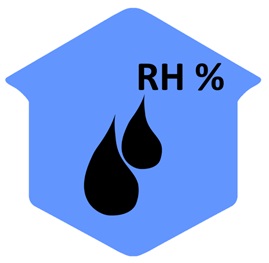Beneficial tips as preventive action during installation
of acoustical walls & ceilings during the
critical monsoon season
It’s that time of the year when India as a tropical country celebrates the monsoon season. Most welcome the rains with glee though some find it irksome. Our economy still depends on a good monsoon for a good harvest. It is also an important time of the year that we take care of our acoustical installations. Anutone shows you how with these tips.

Humidity Is Always THE Problem
The interior environment of a construction site is always high on humidity given the residual dampness from civil works and dense population of work crews from different services all operating simultaneously towards meeting impossible project timelines.
Often the civil works are not fully completed, for example, the brick wall plastering or floor PCC work is still going on and the main contractor is constrained to commence the false ceiling and wall panelling works in parallel to adhere to project timelines.
During monsoon season the external humidity is very high and this means the interior humidity due to natural dampness of civil works and high-wattage lamps used by work crews, that generate lots of heat, results in steam cooker like conditions of RH99 at 40+oC which can be harmful for acoustical panels.
But There is NO Ideal Solution
It is not possible to reach an ideal situation of sequencing itemized works nor is it possible to extend project timelines indefinitely. Hence here are a few practical tips and trade tricks to see you through a successful snag-free installation of acoustical panels that are usually very sensitive to the environment.


The Solution is to Sequence Acoustics Last
Acoustical tiles, boards and panels are usually the final finishing surface of a ceiling or wall. Hence, similar to any fabric or wallpaper treatment, they must be installed last in sequence after all the services and interior works are done that includes carpeting and the airconditioning is switched on. Of course this does not apply to products where wet jointing is necessary like in Snazz Series and Tufbloc.
But Frame It First
This means the suspension system of the ceiling and framing hardware on walls must be installed first along with other services and interior works because this usually involves dust and noise nuisance. Also because the other services like airconditioning and lighting need the primary acoustic framing as a reference for their line level and fixtures.
Even acoustic infill like SynthPF can be positioned in place and the installation made ready in all respects to receive the surface finishing panel.


And Frame it Closer
While the standard framing centres for most acoustical panels is 600mm and a special 400mm for some like Salon Slats Surco, it is prudent to frame it closer and raise the RH resistance of installations if high humidity conditions are expected to perenially exist. Yes this is true and a classic example is the Snazz series of large-format perforated gypsum boards from Anutone. Products like Pixel 3/8, Ellipse or Cosmos are usually framed at 600mm centres for upto RH70 installations. However their framing at 300mm or even 400mm centres raises their resistance up to RH90. Essentially it prevents the system installation from any warp or sag.
Acoustics Being Very Sensitive
Acoustic panels being made of softfibre or wood-based or fabric-wrapped or composites are usually sensitive to harsh environments and manufacturers like Anutone recommend their installation under standard occupancy conditions. In industry parlance, standard occupancy conditions means indoor humidity at RH65 and temperature at 27oC (max RH70 at 30oC) which during monsoons is achievable only with dehumidifying ventilation or air-conditioning.
Hence, acoustic panels can usually be removed from their packing and installed only after the air-conditioning of the facility is switched on and panels allowed to acclimatize for 24 hours.


And Handle Them With Care
Moreover those acoustical panels with a superwhite surface finish like Subtex Nubby, Stretch SLS, Pixel Square 3/8 or fabric-based like Subtex NRC, Stretch Hush, Soak Cord are super sensitive to fingerprints and dust so it makes eminent sense to install them only when the carpeting is done and the furniture comes in. This of course does not apply to wet jointed panels like Snazz Series and Tufbloc.
Plus there are wood-based panels like Salon Slats Surco that are super sensitive to high humidity and dampness. Again it makes immense sense to install their framing like Strut CC18 and infill like SynthPF while waiting it out for others to finish before the Slats planks are finally fixed.
Another Trick is Infill like SynthPF
Even if a thermo-acoustic infill like SynthPF is not strictly required for enhanced acoustic performance it may still be essential for thermal insulation, humidity balance and condensation prevention. The importance of SynthPF for high humid conditions cannot be under emphasised. The product itself is resistant upto RH99 conditions and if it gets wet under damp or moisture conditions it still retains its form, shape and character if allowed to dry completely. SynthPF helps prevent sudden temperature and humidty gradients apart from providing thermal envelopes to rooms, keeping them cool in summers and warm in winters – a power saving feature and green building initiative.


Take Care of Expansion Joints
Finally some installations like Salon Slats Surco require expansion joints every 5m or so in either direction due to their higher coefficients of linear expansion. This is a product characteristic born out of material sciences that represents a physical phenomenon. It is normal. Hence it is best to account for it rather than counter it with butt-joint seamless finishes. The latter can result in warpage and the need for a re-install with provision for expansion joints.
Select Products Wisely
Most acoustical products from Anutone work well under humid conditions provided precautions are taken as above. However if very high humid conditions are likely to be prevalent and persist all through the year as in non-AC interiors of coastal regions then the following product selection might help:
Soft Softfibre – Sisoli Plus Series boasts RH99 resistance whereas Subtex Series works very well upto RH95
Serge Metal – Astral Plus in aluminium is just what the doctor ordered for RH99 resistance
Ekcel Magnesia – Most if not all products including Mat, Strand and Tufbloc work very well upto RH95
Synth Polyfibre – Most products including Stretch and Spun Series are RH95 resistant whereas SynthPF is good for RH99 and beyond
Snazz Gypsum and Salon Wood – Not recommended for RH90 and above conditions. Standard framing applies upto RH70 and closer framing for RH70-RH90 conditions.


Some More Smart Remedies
If an installation is made under adverse conditions and snags have cropped then its best to resolve at source. If fungus has developed on Salon Slats Surco, for example, then remove the sources of dampness in the room and dehumidify the air by switching on the airconditioning and hey presto the problem vanishes. Blame the product and replace it, well, the same problem resurfaces!
Again if panels like Salon Slats Surco are installed at 600mm centres with no expansion joints then re-installation with additional framing of CC18 in between (resulting in 300mm centres) and cutting off the tongue edges from the panels at expansion joints helps retrieve the installation. This will in no way detract from the overall aesthetics as it becomes a regular pattern across the installation
If damp patches appear on panels like Mat or Strand Colours then again the board is breathing and doing its work of bringing equilibrium to the atmosphere by absorbing excess humidity. Remove the sources of high humidity and Strand will be back to the pristine original glory.
